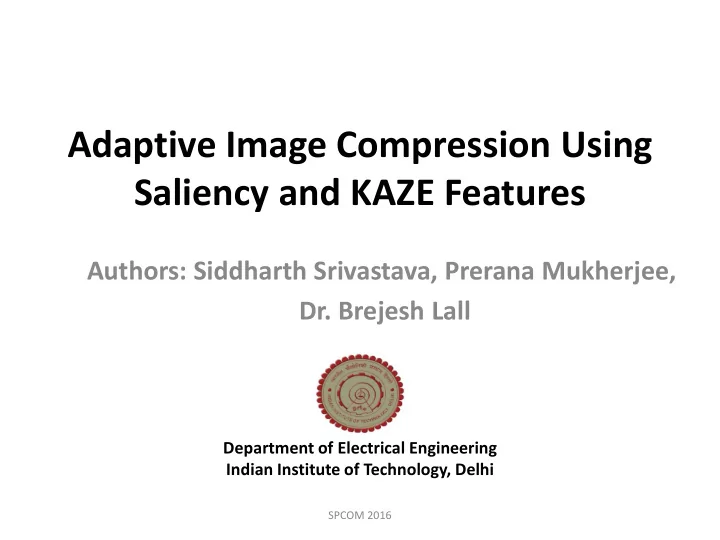

Adaptive Image Compression Using Saliency and KAZE Features Authors: Siddharth Srivastava, Prerana Mukherjee, Dr. Brejesh Lall Department of Electrical Engineering Indian Institute of Technology, Delhi SPCOM 2016
Overview • Introduction • Background • Proposed Methodology • Experimental Results and Discussions • Conclusion SPCOM 2016
Introduction • Primary Objectives – To achieve image compression based on importance of the contents in the image. – Utilize properties from local regions to identify region importance. SPCOM 2016
Introduction • Underlying Principles – Differed Importance : The human eye gives more importance to salient regions – Transition : The surrounding regions around salient objects make them distinguishable – Rejection : Perceptually less significant Pixels/Regions can be made further insignificant – Object Characterization • Well defined boundary • Distinctive appearance • Uniqueness SPCOM 2016
Introduction • Core Methodology – We adapt the quality factor in JPEG compression scheme for each block instead of a global quality factor – This adaptation of quality parameter is based on saliency map and strength of KAZE keypoints SPCOM 2016
Introduction • Key Contributions: – JPEG Compatible – First to introduce KAZE for image compression – Maintains better perceptual quality at high compression ratios SPCOM 2016
Background: Saliency Map Form Activation Maps based on those features Extraction of Combining Maps features from the for different Image features into one Saliency Map Generation SPCOM 2016
Background: Saliency Map Computation Weighted Combination Aimed at segmenting objects P. Mukherjee, B. Lall, and A. Shah, “Saliency map based improved segmentation,” in Image Processing (ICIP), 2015 IEEE International Conference on . IEEE, 2015. SPCOM 2016
Background: KAZE • KAZE is a recent feature detection technique which exploits the non linear scale space to detect keypoints along edges and sharp discontinuities. • Non linear diffusion filtering allows KAZE to achieve less blurring on edges as compared to Gaussian Blurring. SPCOM 2016
Saliency Map and KAZE a) b) c) Fig. 1: (a) Original Image (b) Saliency Map (c) KAZE keypoints SPCOM 2016
Proposed Methodology Fig. 2: Architecture of (a) Compression and (b) Decompression SPCOM 2016
Adapting Quality Parameter (QP) with Saliency Response i: the 8x8 block in the image M. T. Khanna, K. Rai, S. Chaudhury, and B. Lall, “Perceptual depth preserving saliency based image compression,” in Proceedings of the 2nd International Conference on Perception and Machine Intelligence . ACM, 2015, pp. 218 – 223. SPCOM 2016
Adapting Quality Parameter (QP) with Keypoint Response i: the 8x8 block in the image SPCOM 2016
Algorithm I: Algorithm for Piecewise Adaptive QP – Q Sal = Q JPEG * salBoost – M R = mean(image_response) – B S = blockStrength β1 * Q Sal if B S = 0 and salBoost < 1 if B S = 0 and salBoost ≥ 1 Q Sal or B S ≥ α * M R and B S < (1- α ) * M R boostedQP = (1- α) * if α * M R Q Sal (1+α) * if B S < (1- α )*M R and B S ≤ (1+α)*M R Q Sal β2 * Q Sal otherwise SPCOM 2016 *0 < α ≤ 0.5, β1 < 1 and β2 > 1
Results Fig. 3: (a) Plot showing the change in PSNR rate as the compression ratio changes (b) Plot between FSIMc with the varying compression ratio SPCOM 2016
Results a) b) c) Fig. 4: (a) Original Image (b) Results after JPEG compression (c) Results after Adaptive Compression (Proposed Approach) SPCOM 2016
References • P. Mukherjee, B. Lall, and A. Shah, “Saliency map based improved segmentation,” in Image Processing (ICIP), 2015 IEEE International Conference on . IEEE, 2015. • M. T. Khanna, K. Rai, S. Chaudhury, and B. Lall, “Perceptual depth preserving saliency based image compression,” in Proceedings of the 2nd International Conference on Perception and Machine Intelligence . ACM, 2015, pp. 218 – 223. • F. Alcantarilla, A. Bartoli, and A. J. Davison, “ Kaze features,” in Computer Vision – ECCV 2012 . Springer, 2012, pp. 214 – 227. SPCOM 2016
SPCOM 2016
SPCOM 2016
KAZE: Background SPCOM 2016
KAZE: Background SPCOM 2016
KAZE: Background SPCOM 2016
KAZE: Background SPCOM 2016
KAZE: Background SPCOM 2016
KAZE: Keypoint Detection equation for building non linear scale space using AOS SPCOM 2016
Non linear vs linear scale space Comparison between gaussian blurring and nonlinear diffusion SPCOM 2016
KAZE: Keypoint Detection Feature detection SPCOM 2016
KAZE: Keypoint Detection Scharr edge filter The Scharr operator is the most common technique with two kernels used to estimate the two dimensional second derivatives horizontally and vertically. The operator for the two direction is given by the following formula: SPCOM 2016
Feature description KAZE: Keypoint Description SPCOM 2016
KAZE: Keypoint Description SPCOM 2016
Piecewise function for further adapting QP SPCOM 2016
Recommend
More recommend